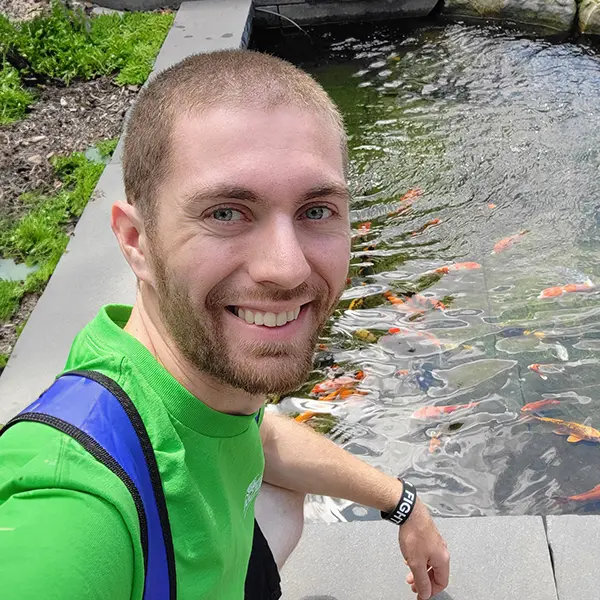
What’s the Average Size for a Koi Pond in Minnesota?
The typical koi pond in Minnesota measures about 10’ x 15’ feet, providing roughly 150 square feet of aquatic paradise. The standard depth is around 32 inches, deep enough to protect koi and goldfish during our harsh Minnesota winters. These designs usually include underwater plant shelves for water lilies and other aquatic plants.
While 150 square feet may be the average size, this doesn’t mean that all ponds have to be this size. Koi ponds can be many different sizes and include many different design elements based off what fits in your yard. Some of these influencing elements include factors such as:
-
Available Space: The size of your property can dictate the pond’s dimensions. A small space can still have a large pond, but you may or may not want to fill that entire space with a water feature.
-
Streams and Waterfalls: These features may increase the overall size and allow for a larger water feature that meanders through a narrower space and between choke-points in your yard.
-
Design Preferences: Each homeowner’s style can affect the shape and size of the pond. A natural ecosystem pond can take any shape and flow with the landscape, but maybe a more refined and rigid style suits your preferences more and needs a bit more design to fit perfectly.
-
Inclusion of Wetlands and Bogs: Adding a wetland or bog area can expand the pond’s footprint without adding more “pond water” area to your feature.
Why Depth Matters in Your Koi Pond
Depth around the Twin Cities is very important for the health of your pond and its inhabitants with the cold weather we experience. Here’s what you need to keep in mind when constructing your koi pond:
-
Fish Health: A minimum of 30 inches is recommended to prevent freezing and provide a safe hibernation space for koi. However, while 2’ is minimum and doable, deeper is better for your fish and for your maintenance. Deeper ponds regulate temperature better. Designing your pond with 3’ deep sections allows for an easier winter maintenance plan and less stress on your fish during the extremely cold below zero snaps we inevitably get around January and February.
-
Plant Health: Shelves placed at about 12 inches and 24 inches are perfect for aquatic plants. When winter comes, your hardy perennials will often want to be deeper than during the summer to escape the cold ice forming on the surface. Having several different levels to your pond will allow you to balance the ecosystem during every season.
How To Determine the Right Location, Depth, and Size of Your Koi Pond
When planning your Minnesota koi pond:
-
Consider the sun exposure: Aim for at least six hours of direct sunlight daily. Shade-tolerant plant varieties exist but generally require less shade to thrive. You also don’t want full sun as algae loves lots of sun and lots of heat. Somewhere in the middle is best.
-
Choose the pond style for you: Koi ponds come in many shapes and sizes. From natural ecosystem ponds dug into the ground to raised pre-formed garden ponds. Ponds dug into the ground maintain their temperature better due to the surrounding ground providing insulation, but that doesn’t mean that a raised pond can’t happen here in our cold state. Raised ponds are definitely possible with a bit more thought to summer and winter care.
-
Think of size: When it comes to ecosystem koi ponds, the bigger it is the smaller the swings in your water will be. With this in mind, the best pond size for easiest maintenance is often the largest pond that will fit in your space and budget. Weather and environmental affects will be felt less in a 500 square foot recreational pond than they will be in a 10 square foot container pond.
Volume Calculation Formulas for Your Pre-Existing Koi Pond
If you’re trying to calculate a current pond you already have or trying to plan for an upcoming pond build, take your measurements and use these formulas to calculate the pond volume:
-
Round Ponds: Use the formula (Diameter/2)^2 x π x average depth x 7.48. For example, if the diameter is 10 feet and the average depth is 2 feet, the pond holds about 1,175 gallons.
-
Rectangular Ponds: Multiply the average length, width, and depth, then multiply by 7.48 to convert cubic feet to gallons. For example, the average pond size with a length of 10 feet, a width of 15 feet, and an average depth of 2 feet would hold approximately 2,244 gallons of water.
For larger natural ponds in our Land of 10,000 Lakes, you can also calculate based on acreage, with one acre-foot equaling about 325,851 gallons.
Planning Your Koi Pond Construction Project
When you’re ready to start your pond project in Minneapolis, St. Paul, or elsewhere in Minnesota, Superior Ponds is here to help. Whether you want to DIY your pond or have a professional do it all for you, we have options for you. With our expertise, we can ensure your pond is a perfect fit for your landscape and lifestyle, providing a peaceful escape in your backyard.
For the DIYer, visit our Pond Blog and check out our pond construction articles to learn how to build an amazing water feature on your own! For the hands-off water lover, check out our popular pond packages and pricing to see how you can have your own Superior Pond and love your yard again!
Whichever direction you go, we invite you to embrace the tranquility of a water garden any way you can, because water features really are a way of life. Whether you do it yourself or hire a pro, we’re here for you, connecting people to water the way nature intended.
Start Your Dream Pond

For unmatched pond building services in Southern Minnesota, contact Superior Ponds at (952) 491 0765.
